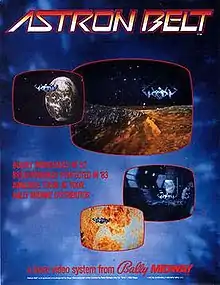Astron Belt
Astron Belt (アストロンベルト) is a LaserDisc video game in the form of a third-person, space combat rail shooter released in arcades in 1983 by Sega in Japan, and licensed to Bally Midway for release in the United States.[4][5] Developed in 1982,[6] it is commonly cited as the first LaserDisc game.[4][5]
| Astron Belt | |
|---|---|
 Promotional flyer | |
| Developer(s) | Sega |
| Publisher(s) | Sega (Japan) Bally Midway (NA) |
| Platform(s) | Arcade, MSX |
| Release | |
| Genre(s) | Rail shooter |
| Mode(s) | Single-player |
| Arcade system | Sega Laserdisc |
The game's unveiling at the 1982 AMOA show in Chicago marked the beginning of LaserDisc fever in the videogame industry, and its release in Japan the following year marked the first commercial release of a LaserDisc game. However, its release in the United States was delayed due to several hardware and software bugs, by which time Dragon's Lair had beaten it to public release.[4] Astron Belt was, however, the first laserdisc game released in Europe.[7]
The arcade game was available in both upright and cockpit cabinets, with the latter having illuminated buttons on the control panel, a larger 25" monitor (the upright used a standard 19"), and a vibrating seat. Astron Belt was ported to the MSX home system in 1984 in Japan.
Gameplay
The player controls a lone spacecraft on a mission to singlehandedly take down the entire enemy armada. Enemy fighters and ships shoot at the player, and there are mines and other objects that must be shot or avoided.
The game is divided into waves. At the end of each wave is a command ship that must be destroyed. In later waves the enemy fighters move and shoot more aggressively, and their shots are more accurate. Some waves take place in open space, while others require the player to battle enemies while flying through narrow trenches and tunnels. The player is on a timer at the beginning of the game, with an unlimited number of lives available. The length of the timer can be adjusted by the machine operator, but is normally 60 seconds. After the timer expires, the player is given a limited number of additional lives. When all of those lives are lost, the game ends.
The background videos used in the game are a mixture of original artwork and borrowed material. In addition to the scenes created specifically for the game, the designers also incorporated footage from three science fiction movies: Star Trek II: The Wrath of Khan, Battle Beyond the Stars, and Message from Space.
Technical
Astron Belt used one of four laserdisc players, either a Pioneer LD-V1000 or LD-V1001, or a Hitachi VIP-9500SG or VIP-9550. Two different versions of the laser disc itself were also pressed, a single-sided version by Pioneer and a double-sided version by Sega. However, both discs have the same information and may be used in any of the four players.
Running on the Sega Laserdisc hardware, the game combines pre-rendered laserdisc footage with a real-time 2D computer graphics plane. The real-time graphics plane was overlaid by imitating a matting technique. As the CRT monitor scans horizontally across the screen, it is fed information from the laserdisc up until the point where it is fed information from the computer graphics system, after which information coming from the laserdisc stops, creating a black mask into which a sprite is inserted. It uses a collision detection system where both the laserdisc and sprite planes can interact with each other. Each frame of the laserdisc footage is coded with a hit detection spot stored in ROM memory. The Zilog Z80 CPU reads the number of the laserdisc frame, and checks the laserdisc hit spots with the shots fired by the player, and if the coordinates correspond, it instructs the laserdisc player to display an explosion sequence. For sections where the player must navigate between walls, the walls in the laserdisc footage are also coded and use collision detection.[8]
Reception
In Japan, Game Machine listed Astron Belt on their June 1, 1983 issue as being the most-successful upright arcade unit of the year.[9]
Legacy
Astron Belt was responsible for starting the interactive movie laserdisc craze when it was shown at the 1982 AMOA show. One of the laserdisc games it inspired was Dragon's Lair.[10]
Sega and Bally Midway released a sequel called Starblazer (also known as Galaxy Ranger) in 1984. It had the same controls and very similar gameplay to Astron Belt, and one machine could be converted to the other by simply changing the laserdisc, game ROMs, and sound board. In Japan, Game Machine listed Starblazer on their January 15, 1984 issue as being the third most-successful upright arcade unit of the year.[11]
References
- "Astron Belt arcade video game pcb by SEGA Enterprises (1983)". Arcade-history.com.
- Computer and Video Games, issue 22 (August 1983), page 30 Archived 2015-09-24 at the Wayback Machine, published 16 July 1983
- "Astron Belt arcade video game pcb by Bally Midway Mfg. (1983)". Arcade-history.com.
- "ASTRON BELT". Atari HQ. Archived from the original on 20 March 2011. Retrieved 2011-03-25.
- Astron Belt at AllGame
- Mark Isaacson (2002). "The History of Sega: From Service Games to Master Systems". Retrieved 2011-03-25.
- "Astron Belt arcade game review". Solvalou.com. Retrieved 2018-01-05.
- "Photographic image of book page" (GIF). Dragons-lair-project.com. Retrieved 23 January 2018.
- "Game Machine's Best Hit Games 25 - アップライト, コックピット型TVゲーム機 (Upright/Cockpit Videos)". Game Machine (in Japanese). No. 213. Amusement Press, Inc. 1 June 1983. p. 29.
- Wolf, Mark J. P. (2008). The Video Game Explosion: A History from PONG to Playstation and Beyond - Mark J. P. Wolf - Google Books. ISBN 9780313338687. Retrieved 2018-01-05.
- "Game Machine's Best Hit Games 25 - アップライト, コックピット型TVゲーム機 (Upright/Cockpit Videos)". Game Machine (in Japanese). No. 228. Amusement Press, Inc. 15 January 1984. p. 31.